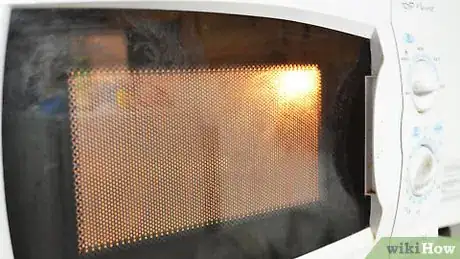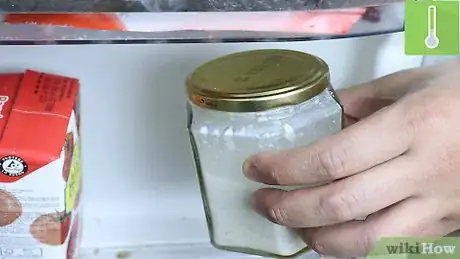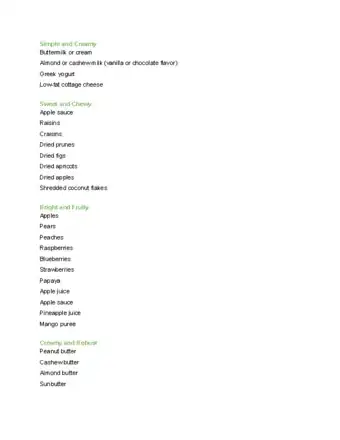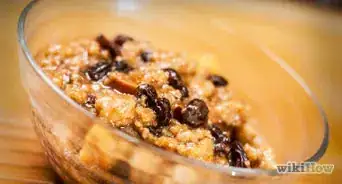This article was co-authored by wikiHow Staff. Our trained team of editors and researchers validate articles for accuracy and comprehensiveness. wikiHow's Content Management Team carefully monitors the work from our editorial staff to ensure that each article is backed by trusted research and meets our high quality standards.
There are 15 references cited in this article, which can be found at the bottom of the page.
The wikiHow Culinary Team also followed the article's instructions and verified that they work.
This article has been viewed 2,420,966 times.
Learn more...
Oatmeal is a tasty, nutritious way to start your day. And, since it can be prepared so many different ways, it also makes an incredibly quick and easy breakfast option for hectic mornings!
Ingredients
- 1/2 cup (45 g) old fashioned rolled, steel-cut, or instant oats
- 1 cup (240 ml) water or milk
- 1 cup (240 ml) almond, coconut, soy milk, or other non-dairy alternative (optional)
- Various toppings, spices, and additives (to taste)
Steps
Microwaving Oatmeal
-
1Pour the oatmeal into a microwave safe bowl. For most types of oats, like quick-cooking or rolled oats, an average serving size is about ½ cup (45 g). If you’re preparing instant oatmeal, simply open the package and dump the contents into the bowl—they’re pre-portioned, so there’s no need to do a lot of measuring.[1]
- Use level scoops with a dry measuring cup to portion out loose oats.
-
2Add 1 cup (240 ml) of water and stir. Fill a liquid measuring cup to the 1 cup (240 ml) mark with cold water, then pour it on top of the dry oats. Give the oats a stir until the water is evenly distributed throughout. There should be no clumps or dry spots in the bowl.[2]
- 1 cup (240 ml) of water may look like a lot in ½ cup (45 gm) of oats, but keep in mind that the oats will absorb moisture quickly when cooked.
- For thicker, creamier oatmeal, you can also use milk in place of water.
Advertisement -
3Microwave the oatmeal for 1½-2 minutes. Stick the oats in the microwave and heat them on high power. For softer, creamier oatmeal, set the cook time to 1½ minutes. If you’d prefer a thicker bowl, up the time to 2 minutes, or even slightly longer.[3]
- If you’re making a heartier kind of oatmeal, like traditional rolled or steel-cut oats, you may need to increase the cook time to 2½-3 minutes to make sure they’re tender.[4]
-
4Stir the oatmeal thoroughly. Remove the bowl from the microwave carefully—it will be hot! After another quick stir, your oatmeal will be ready to eat.
- Allow the oatmeal to cool for a minute or two before you take your first spoonful.
-
5Mix in your favorite flavors. At this point, you can add a few healthy and delicious toppings, such as butter, honey, cream, fresh berries, dried fruit, or toasted nuts. Just stir in as much or as little as of each ingredient as you'd like and enjoy![5]
- Give packaged instant oatmeal a taste before adding anything else. These tend to be flavored with additives like brown sugar, cinnamon, and apples, so they might not need much.
Cooking Rolled or Steel-Cut Oats on the Stove
-
1Fill a shallow pot with 1 cup (240 ml) of water or milk. Use a standardized measuring cup to make sure you have just the right amount of liquid. Oats simmered in water will cook faster and retain more of their original firmness. Preparing your oatmeal with milk will lend it more of a soft, smooth texture.[6]
- A smaller pot, like a saucepan, will provide the best results, since the oats need to be partially submerged in order to cook.
- Only steel-cut or rolled oats should be prepared on the stovetop. Other varieties, like packaged instant oatmeal and quick-cooking oats, are designed to be cooked in the microwave.[7]
-
2Bring the water or milk to a low boil. Heat the pot over medium-high heat until it just begin to bubble. This is the optimal temperature for simmering oats. It’s important to boil the water or milk before you add the oats so that they don’t absorb too much moisture and become soggy.[8]
- You can also use a combination of milk and water for creamier oatmeal without an excessive amount of calories.[9]
- Be careful not to let the water or milk get too hot, or it will evaporate quickly and cause the oatmeal to scorch.
-
3Add ½ cup (45 gm) of oats and stir. Portion out your oats using level scoops with a dry measuring cup. ½ cup (45 g) of oats is considered a standard serving for one person. If you want to make more, simply make room for an extra ½ cup (45 g) of oats and ¾-1 cup (180-240 ml) of water or milk.[10]
- Throw in a pinch of salt to give the oats more flavor. Add a splash of vanilla into the oats for added sweetness.
-
4Simmer the oatmeal until it reaches the desired consistency. Stir the oatmeal periodically while it's cooking, but avoid giving it too much attention. Exact cook times will vary depending on the amount and type of oats you’re preparing. Rather than watching the clock, keep a close eye on the oatmeal as it thickens.[11]
- It may take anywhere from 8-10 minutes to simmer a pot of old fashioned rolled oats. Because of their tougher texture, steel-cut oats may require as long as 20 minutes to soften up.[12]
- Over stirring oats breaks down their starches, causing them to turn gluey and neutralizing much of their natural flavor.
-
5Remove the oatmeal from the heat. Once the oatmeal has taken on your preferred texture, transfer it to a deep serving bowl. Using a spoon or spatula to scrape the sides of the pot will spare you some added cleanup later on. And, of course, make sure the bowl you're using is large enough to hold whatever other toppings you plan on incorporating.
- Keep in mind that the oatmeal will continue to thicken a little as it cools, so it may be a good idea to take it off the stovetop a tad before it looks just right.
-
6Mix in other flavorful additives. While the oatmeal is piping hot, add a pat of butter, a spoonful of natural peanut butter, or a handful of raisins. If you like it sweet, try sprinkling on a little brown sugar, maple syrup, honey, or fruit preserves. It's hard to go wrong![13]
- Spices like cinnamon, nutmeg, and allspice can offer a good counterbalance to sweeter ingredients.[14]
- Allow the oatmeal to cool to a safe temperature before digging in.
Making Oatmeal with Boiling Water
-
1Bring a kettle of water to a boil. Fill a tea kettle with fresh water and place it on the stovetop over high heat. An electric tea kettle will also work just fine. While the water is warming up, you can go ahead and get the other components of your breakfast ready.
- This method can be used to prepare packaged instant oatmeal as well as the slower-cooking steel-cut and rolled varieties.
-
2Pour ½ cup (45 g) of oats into a bowl. This will make enough oatmeal for a single person. For larger servings, portion out another ½ cup (45 g) of oats at a time. You’ll need to add ½-1 cup (120-240 ml) of boiling water for every ½ cup (45 g) of oats you’re preparing.[15]
- Using a dry measuring cup will help you get a more precise oat-to-water ratio.
- Add a pinch of salt to the dry oats to bring out more of their flavor.
-
3Pour the boiling water over the oats. Once the water reaches a boil, turn off the heat and open the spout to allow some of the steam to escape. Stir the oats continuously as you drizzle in the water. For softer oats, use about 1¼ cups (300 ml) of water. If you prefer your oatmeal nice and thick, stop at ¾-1 cup (180-240 ml).
- The oats will puff up and thicken as they cook, which means it’s usually better to use a little more water than you think you need.
-
4Let the oatmeal cool prior to eating. After pouring in the boiling water, the oatmeal will be scalding hot for several minutes. To avoid burning your mouth, hold off on taking a bite until most of the steam has dissipated. You’ll be glad you did once you get that first taste!
- A splash of cream or a dollop of Greek yogurt will help fresh-cooked oats cool off quicker.[16]
-
5Add your toppings of choice. Sweeten up a bowl of plain oats with honey, brown sugar, or maple syrup. Then, heap on banana slices, granola clusters, or semisweet chocolate morsels. Finish with a dash of cinnamon sugar or apple pie seasoning.[17]
- Don’t be afraid to play around with unusual flavors like dried cherries, pistachios, or shaved coconut when you feel like something a little different.
- Try serving your oatmeal like an acai bowl—stir in blended acai berry smoothie and other wholesome ingredients like chia seeds, nut butters, and fresh fruit.[18]
Fixing Overnight Oatmeal with Rolled Oats
-
1Scoop ½ cup (45 g) of rolled oats into a small container. Mason jars are ideal for this purpose, since they’ll offer you the ability to control your portion size. However, any deep, open container will work. Once the oats are inside, give them a shake to level them.[19]
- Rolled oats work best for making overnight oatmeal—instant oats will quickly become mushy once liquid is added, while steel-cut oats won’t soften enough, and will remain dry and tough.[20]
- If your mornings tend to be pretty frenzied, mix up your overnight oatmeal in a plastic storage container so you can savor it on the go.
-
2Add an equal portion of milk or non-dairy milk substitute. Pour in about ½ cup (120 ml) of cold milk, or use almond, coconut, or soy milk instead. This will provide the moisture for the oatmeal. You’re aiming for approximately a 1:1 ratio of oats to milk.[21]
- It may take a couple trial runs before you get the proportions exactly right. If your overnight oatmeal turns out a little soggy the first time, cut back on the amount of milk you use on your next attempt. If they’re overly dry, add an extra splash just before serving.[22]
-
3Stir the contents of the container thoroughly. Keep stirring until the texture of the oats is consistent from top to bottom. Otherwise, you’ll end up with unappetizing dry patches.[23]
- You can also add other dry ingredients at this stage, such as chia seeds, flax, and ground spices.
-
4Refrigerate the oats overnight. Cover the container and place it on the center shelf of your refrigerator. As the oatmeal sits, it will slowly absorb the milk and become plump and tender. It will need 3-5 hours before it’s ready to eat. For the smoothest possible texture, leave it for 7-8 hours.[24]
- If the container you’ve selected doesn’t come with a built-in lid, secure a piece of plastic wrap or aluminum foil around the opening.
- Refrigerating overnight oats for longer than abut 10 hours may result in a soggy, inedible mess.
-
5Top with your favorite flavors and enjoy cold. After the oatmeal comes out of the fridge, fill the container the rest of the way with tasty toppings like honey, Greek yogurt, or chocolate-hazelnut spread. Health-conscious eaters can turn to more nourishing offerings like fresh fruit and unsweetened nut butters instead.[25]
- Try using mashed bananas to supply sweetness rather than traditional sweeteners.[26]
- Get creative! There’s virtually no limit to the number of unique flavor combinations you can come up with.
- If the idea of chowing down on cold oatmeal doesn't appeal to you, you can also pop an individual serving in the microwave for a minute or two.
Oatmeal Add-In Ideas
Community Q&A
-
QuestionIs cooking time the same if I increase the amount of oatmeal?
 Community AnswerIf you increase the amount of oatmeal, then you may have to increase the cooking time slightly to get the same consistency. Just keep an eye on the oatmeal and turn it off whenever it gets to the consistency you desire.
Community AnswerIf you increase the amount of oatmeal, then you may have to increase the cooking time slightly to get the same consistency. Just keep an eye on the oatmeal and turn it off whenever it gets to the consistency you desire. -
QuestionHow I make oatmeal with only water in an electric kettle?
 Community AnswerJust put the oatmeal in a bowl, boil some water in the kettle, pour the hot water over the oatmeal, and let it sit and 'make' itself for a few minutes.
Community AnswerJust put the oatmeal in a bowl, boil some water in the kettle, pour the hot water over the oatmeal, and let it sit and 'make' itself for a few minutes. -
QuestionWhy do people seem to have trouble following the instructions on the box?
 Community AnswerSome people might have thrown away the box without looking at the directions, or they may struggle to follow written instructions (especially if they have something like dyslexia). It can be nice for some people to have step-by-step pictures along with the opportunity to ask questions.
Community AnswerSome people might have thrown away the box without looking at the directions, or they may struggle to follow written instructions (especially if they have something like dyslexia). It can be nice for some people to have step-by-step pictures along with the opportunity to ask questions.
Warnings
- It’s a good idea to clean your pot immediately after making oatmeal on the stovetop. Once the remnants dry, they’ll be next to impossible to get off without a long soak.⧼thumbs_response⧽
- Never leave a boiling pot or kettle unattended. Not only is this a fire hazard, but you also risk ruining your breakfast!⧼thumbs_response⧽
Things You'll Need
Microwaved Oatmeal
- Microwave
- Microwave-safe serving bowl
- Measuring cups (for both dry and liquid ingredients)
- Spoon
Stovetop Oatmeal
- Shallow pot or saucepan
- Measuring cups (for both dry and liquid ingredients)
- Spoon
Boiling Water Oatmeal
- Tea kettle
- Measuring cups (for both dry and liquid ingredients)
- Spoon
Overnight Oatmeal
- Mason jar or similar container
- Measuring cups (for both dry and liquid ingredients)
- Spoon
References
- ↑ http://www.geniuskitchen.com/recipe/perfect-microwave-oatmeal-for-one-412086#activity-feed
- ↑ http://www.quakeroats.com/cooking-and-recipes/how-to-prepare-oats.aspx
- ↑ http://www.geniuskitchen.com/recipe/perfect-microwave-oatmeal-for-one-412086#activity-feed
- ↑ https://www.thekitchn.com/whats-the-difference-between-steel-cut-rolled-and-instant-oats-138355
- ↑ https://www.slenderkitchen.com/recipe/the-best-microwave-oatmeal
- ↑ http://www.quakeroats.com/cooking-and-recipes/how-to-prepare-oats.aspx
- ↑ https://www.thekitchn.com/whats-the-difference-between-steel-cut-rolled-and-instant-oats-138355
- ↑ https://www.sugardishme.com/perfect-stovetop-oatmeal-recipe/
- ↑ https://www.huffingtonpost.com/2013/05/02/how-to-cook-oatmeal_n_3194811.html
- ↑ http://www.quakeroats.com/cooking-and-recipes/how-to-prepare-oats.aspx
- ↑ https://www.thekitchn.com/how-to-make-oatmeal-on-the-stovetop-the-simplest-easiest-method-248339
- ↑ https://www.huffingtonpost.com/2013/05/02/how-to-cook-oatmeal_n_3194811.html
- ↑ https://www.sugardishme.com/perfect-stovetop-oatmeal-recipe/
- ↑ https://www.tasteofhome.com/recipes/oatmeal-spice-mix
- ↑ http://www.quakeroats.com/cooking-and-recipes/how-to-prepare-oats.aspx
- ↑ http://allrecipes.com/recipe/244287/greek-yogurt-oatmeal/
- ↑ http://www.bhg.com/recipes/how-to/cooking-basics/how-to-cook-oatmeal/
- ↑ https://www.huffingtonpost.com/entry/acai-bowl-recipes_us_57323946e4b0bc9cb0485873
- ↑ https://wholefully.com/8-classic-overnight-oats-recipes-you-should-try/
- ↑ http://www.foodnetwork.com/healthyeats/recipes/2015/05/as-you-like-it-overnight-oats-for-breakfast
- ↑ http://www.foodnetwork.com/healthyeats/recipes/2015/05/as-you-like-it-overnight-oats-for-breakfast
- ↑ http://allrecipes.com/recipe/244251/no-cook-overnight-oatmeal/
- ↑ http://allrecipes.com/recipe/244251/no-cook-overnight-oatmeal/
- ↑ http://www.quakeroats.com/cooking-and-recipes/overnightoats
- ↑ https://wholefully.com/8-classic-overnight-oats-recipes-you-should-try/
- ↑ http://www.foodnetwork.com/healthyeats/recipes/2015/05/as-you-like-it-overnight-oats-for-breakfast
About This Article
The easiest way to make oatmeal is to boil ½ a cup of oatmeal in 1 cup of water and stir it as it simmers. Once the oatmeal has thickened to your liking, remove it from heat and add in any flavorings and toppings that you want, like brown sugar, cream, or nuts. Read the article to learn how to make oatmeal by baking or microwaving it!




























































